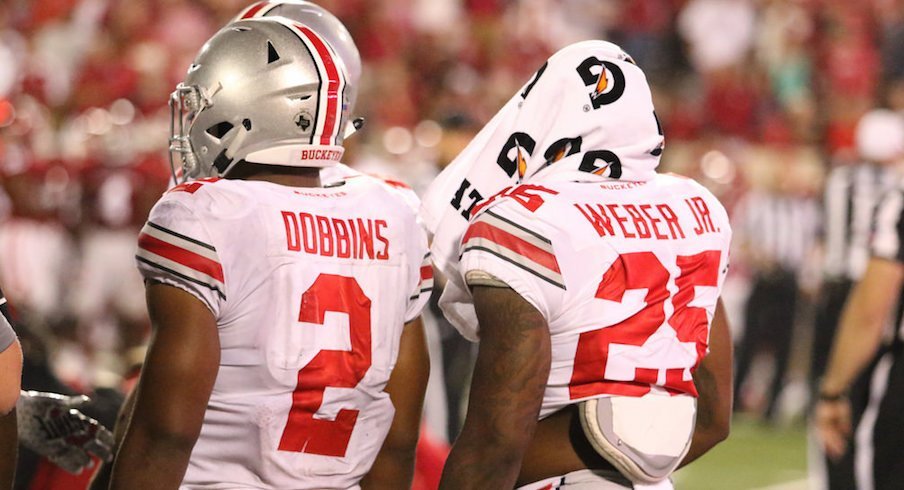All eyes during spring drills focused on the battle between Dwayne Haskins and Joe Burrow to replace J.T. Barrett at quarterback, and rightfully so.
But no matter who wins the battle, the reality is just about any first-year starting quarterback would benefit from having a legit rushing attack to lean on.
Haskins or Burrow will have the ultimately luxury in the form of J.K. Dobbins and Mike Weber combining to form what could be the most prolific non-quarterback rushing duo since Urban Meyer arrived in Columbus in late 2011.
So what is the benchmark for non-quarterback rushing duos since Meyer came home? Here's a breakdown:
| YEAR | RUSHER 1 | RUSH YPG | RUSHER 2 | RUSH YPG | COMBINED RUSH YPG | RANK |
|---|---|---|---|---|---|---|
| 2017 | J.K. DOBBINS | 100.2 | M. WEBER | 52.2 | 152.4 | 3 |
| 2016 | M. WEBER | 84.3 | C. SAMUEL | 59.3 | 143.6 | 5 |
| 2015 | E. ELLIOTT | 140.1 | B. MILLER | 20.0 | 160.1 | 2 |
| 2014 | E. ELLIOTT | 125.2 | C. SAMUEL | 25.5 | 150.7 | 4 |
| 2013 | C. HYDE | 138.3 | J. HALL | 41.2 | 179.5 | 1 |
| 2012 | C. HYDE | 97.0 | J. HALL | 31.1 | 128.1 | 6 |
Last year, Dobbins and Weber combined for 152.4 rushing yards per game even as Weber missed two games and had five carries or less in five other outings while Dobbins enjoyed a breakout 1,403-yard season.
With Weber dinged at times and clearly in a backup role, Barrett churned out 57.0 rushing yards per game, good for second on the team but still the lowest total posted by any quarterback under Meyer at Ohio State.
In 2016, Weber led the way with 84.3 rushing yards per game and Curtis Samuel averaged 59.3 as he lined up all over the field. The combo tallied 143.6 rushing yards per game, only good for next-to-last since Meyer came to town.
The 2015 season saw Ezekiel Elliott do it all averaging 140.1 rushing yards per game while the No. 2 non-QB rusher was Braxton Miller with 20.0 yards giving the pair a total of 160.1, good for the second-most since 2012.
During the national championship run of 2014, again Zeke led the way with 125.2 rushing yards per game as Samuel chipped in 25.5 for a total of 150.7 which serves as the fourth-best tally under Meyer. From the quarterback spot, Barrett turned in a personal-best 78.2 rushing yards per game that season.
In Meyer's second year in Columbus, the 2013 Buckeyes leaned on Carlos Hyde's 138.3 rushing yards per game complemented by Jordan Hall's 41.2 yards for a total of 179.5 which still stands as the most prolific output by a non-QB combo since Meyer brought his power-spread Ohio Stadium. That output is even more impressive when you consider Braxton chewed up another 89.0 yards on the ground – second-best on the team – as Ohio State's offensive line flexed on opponents.
Year One of the Urban Meyer Experience saw Hyde pace the tailbacks with 97.0 rushing yards per game which combined with 31.1 from Hall gave the combo a tally of 128.1, easily the worst production from the top two non-QB rushers in the Meyer era. Of course, Miller influenced the low total as he ran for a Meyer-era-best 105.9 yards per game to lead the team.
With either Haskins or Burrow not expected to carry the ball as often as Barrett did per game in his career, Dobbins and Weber are licking their chops in anticipation of an increased workload.
We'll see if it actually materializes (lest we forget about the Tate Martell package rumors or an H-back like McCall stealing some carries) but if an increased workload does come to fruition, Dobbins and Weber should be well-positioned to put up the most-prolific non-QB rushing combo season since Meyer took over the program.


